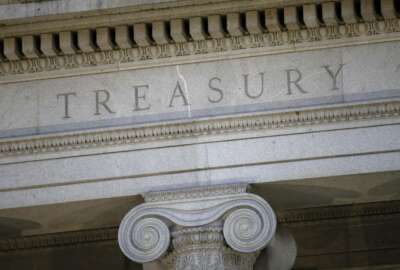Bureau of the Fiscal Service seeks to issue nearly all payments electronically by 2030
The Treasury Department’s Bureau of the Fiscal Service sees an opportunity to modernize the way it does business, after spending much of the COVID-19 pandemic...
The Treasury Department’s Bureau of the Fiscal Service sees an opportunity to modernize the way it does business, after spending much of the COVID-19 pandemic getting stimulus payments out to the public.
In an annual letter to agency chief financial officers, Commissioner Tim Gribben said the bureau plans to disburse nearly all its payments electronically by 2030, while also taking steps to prevent improper payments and migrate its data off legacy formats.
Gribben said in an interview that the bureau made substantial progress delivering more payments electronically over the past decade.
A majority of stimulus payments sent following the 2008 recession arrived as paper checks, but the bureau issued a majority of Economic Impact Payments electronically throughout the pandemic. Those lessons learned continue as the bureau supports the IRS in issuing child tax credits to households.
To keep this modernization effort going, Gribben said the bureau is looking at ways to include digital payments, including Venmo, as one of several options to get government-issued payments out to the public quickly and securely.
“Right now, we’re set up where we have to negotiate with each of the FinTech payment platforms. We’re working now on a solution that allows us to have one payment system, and then be able to tie in multiple payment methods, in even some ones that don’t even exist yet,” Gribben said.
Public opinion, however, determines how quickly the bureau can fully make that shift to electronic payments. That’s why the bureau is bringing together the largest check-producing agencies into a “No Check Coalition,” focused on educating the public about the benefits of receiving payments electronically.
“There are some people who still believe that getting that paper check is more secure when actually it’s not. Our data shows that electronic transactions are much more secure and less prone to fraud than paper checks,” Gribben said.
Aside from weaning the federal financial system off paper, the bureau has identified six trends that agency CFOs need to consider over the next decade:
- Customer and employee experience
- New entrants to the financial market and the rise of FinTech
- Real-time payments
- Predictive analytics
- “People not jobs” — upskilling employees
- Workplace of the future — including telework.
Gribben said the federal financial community also has a role in the Biden administration’s goal of using data and evidence to drive policy decisions at agencies.
“CFOs have to be much more focused in the future on being able to link the performance results and the financial results for the money that Congress is giving us to invest in our programs and services,” Gribben said.
As for short-term goals, the bureau expects to migrate 70 data sets off legacy formats and onto FiscalData.Treasury.gov by fiscal 2024.
The website serves as a one-stop shop for government spending data. The bureau is already halfway in meeting its goal, having migrated 35 data sets onto the site.
“We have data that’s machine-readable. It has complete metadata and data dictionaries, so you can understand the reliability of the data if there are any known quality concerns with the data. We can make that data more accessible to the public through APIs,” Gribben said.
The bureau is also looking to access more interagency data sets to reduce the risk of improper payments.
Gribben said the bureau received approval from the Office of Management and Budget within the past few months to add 12 new data sets to the list of records its Do Not Pay and Payment Integrity Centers of Excellence have access to.
The bureau is also on track to have full access to the Social Security Administration’s Death Master File by 2023, but Gribben said the bureau is working with SSA and OMB on getting that data sooner.
The ability to validate whether someone has died before issuing a payment is a critical way to avoid improper payments. Gribben said the bureau, for example, worked closely with the Federal Emergency Management Agency in the early stages of the funeral assistance program FEMA stood up as part of the American Recovery Plan.
Because of this partnership with the Fiscal Service, FEMA was able to avoid $70 million in potential improper payments.
“They brought us in early in the process, which gave us the opportunity to do account validation, death validation, and use cross-agency data and access that we have to determine whether or not somebody was eligible to receive the benefit, even before they made the payment,” Gribben said.
The bureau is also conducting a workforce assessment to better understand how employees are prepared to adapt to new technology and processes.
To become a leader in fields like cybersecurity and data analytics, Gribben said the bureau is flagging skills gaps and developing training and mentorship to upskill the workforce it already has.
“Maybe they don’t enter into the job certified for a job like cybersecurity or data analytics, but we can provide that opportunity to employees,” Gribben said.
Gribben said the workforce assessment is also giving the bureau a sense of where it needs to hire new talent. To recruit prospective hires, the bureau is thinking beyond its seven office locations, and offering remote work as an incentive.
Gribben said the bureau also launched an employee inclusion action committee that’s looking at how to retain more employees.
“This group is helping us break down those geographic boundaries,” he said. “We might have a job where most of the employees are here in D.C. or in Parkersburg, West Virginia, but now in the future, we can hire them in our other locations or some potentially remote locations.”
Copyright © 2025 Federal News Network. All rights reserved. This website is not intended for users located within the European Economic Area.
Jory Heckman is a reporter at Federal News Network covering U.S. Postal Service, IRS, big data and technology issues.
Follow @jheckmanWFED






